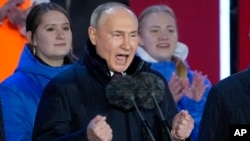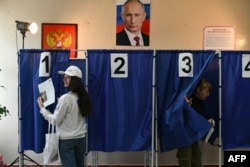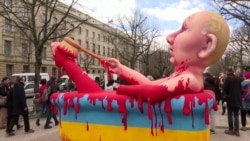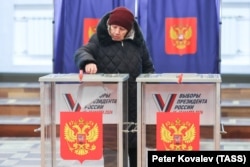Eight years ago, when voting results in Russian parliamentary elections pointed to a massive win for the Kremlin-aligned ruling party United Russia, an award-winning data analyst published a statistical analysis of voting patterns that he said indicated massive fraud.
The graphs from Sergei Shpilkin's findings from that election and earlier ones were so compelling that they entered popular culture as a Churov's Saw -- a jagged, bewildering zig-zag of anomalies named after the man who headed Russia's Central Election Commission from 2007-16.
Shpilkin repeated his model in the 2018 presidential election, asserting that Vladimir Putin may have been awarded about 10 million fraudulent votes.
Now journalists and at least one election researcher applied Shpilkin's model to the just-concluded election that officials say Putin won with nearly 87 percent of the vote, a record for Putin in his 25 years as the country's preeminent leader.
The Findings?
Novaya Gazeta Europe said Putin received at least 31.6 million fraudulent votes, out of about 75 million votes cast. Important Stories, meanwhile, concluded that around 22 million bad votes were given to Putin. Important Stories explained its lower estimate by saying it excluded Moscow's vote tallies because officials combined in-person votes with electronic online voting, and that may have distorted the analysis.
"Never before have we seen a presidential campaign that fell so far short of constitutional standards," Golos, a now-banned election watchdog organization, wrote in its summary report.
Asked by RFE/RL about the journalists' findings, Shpilkin, who last month was designated a "foreign agent" under a punitive Russian law aimed at restricting the work of journalists, civil society activists, and others, declined to comment.
In 2012, Shpilkin won a top Russian political science award for his work on the previous year's parliamentary election.
Outcomes Foretold
For Kremlin experts in and out of Russia, the outcome of the three-day election, which concluded on March 17, was never in doubt. The Kremlin had engineered the campaign to exclude even the semblance of a genuine challenge: A former lawmaker named Boris Nadezhdin who espoused an anti-war political stance while refraining from criticizing the Ukraine invasion, was prevented from appearing on the ballot based on a technicality.
The three contenders who did appear on the ballot were lawmakers or political figures who never criticized Putin or adopted positions that significantly differed from the incumbent's.
The man many Russians saw as a real political threat to Putin -- Aleksei Navalny -- had been shuffled in and out of punishment cells in remote prisons since being arrested in 2021. On February 16, Navalny was found dead in an Arctic prison, prompting an outpouring of outrage and grief.
Months ahead of the vote, the newspaper Kommersant and the news outlet Meduza, citing unnamed officials, said the Kremlin department responsible for overseeing the election had set a target of 70 percent voter turnout and for the winning candidate to get at least 75 percent of the vote.
In the days ahead of the vote, the state-funded pollster VTsIOM issued a survey predicting Putin would receive 82 percent of the vote, with 71 percent turnout.
Official results, announced on March 18 by the Central Election Commission, whose head is a loyal Kremlin appointee, showed that with 100 percent of ballots tallied, Putin had received 87.3 percent of the votes. Turnout was about 77.44 percent -- 87.1 million people -- of all eligible voters. Voting was also conducted illegally in the Russian-occupied parts of Ukraine.
Those results are nearly 10 percentage points higher than Putin's 2018 election results.
But for years, officials have constrained any sort of independent or outside monitoring of voting procedures. Western observer missions have been blocked, Russian monitors like Golos have been forced to flee the country, and even Internet cameras used by monitors to observe hundreds of balloting precincts around the country have been taken down.
Shpilkin's analyses, meanwhile, have been embraced as a verifiable model that holds up to scrutiny and highlights just how election officials allegedly manipulate tallies.
In layman's terms, the model and the graphs derived from it show unusual, jagged anomalies in vote tallies over the course of balloting, as turnout increases. If there was no manipulation, according to this model, then the distribution of votes among Putin and the other candidates would appear smoother, with few sharp deviations.
Researchers say the anomalies can be explained by ballot counters entering fictitious tallies into official records.
Ivan Shukshin, a researcher with Golos, said he came to a similar conclusion using the Shpilkin model, independent of the media reports: 22 million fraudulent votes, a tally he said excluded online voting and voting in Ukrainian territories that Russia claims to have annexed.
Andras Toth-Czifra, a political and risk analyst with the Foreign Policy Research Institute, said Shpilkin's method is convincing but it tends not to catch more sophisticated forms of electoral manipulation, like coerced voting, or the preferences of those who did not participate.
The model, he said, also appears to indicate turnout figures that were "almost certainly significantly lower" than official numbers.
"This is important because engineering a high turnout was one of the main goals of the Kremlin, and the authorities put a lot of effort and resources toward achieving this," he told RFE/RL. "If getting the desired results still required them to invent tens of millions of votes, that tells a lot about the authorities' ability to mobilize voters."
Shukshin, the Golos expert, also concluded that one of Putin's challengers, Vladislav Davankov, had his vote tallies tweaked so that he ended up in third place, behind the candidate from the Communist Party.
Some opposition activists had urged people to vote for Davankov in the slim hope of forcing a second round of voting.
"This was the most filthily falsified presidential election in the country's history," Shukshin wrote.
















